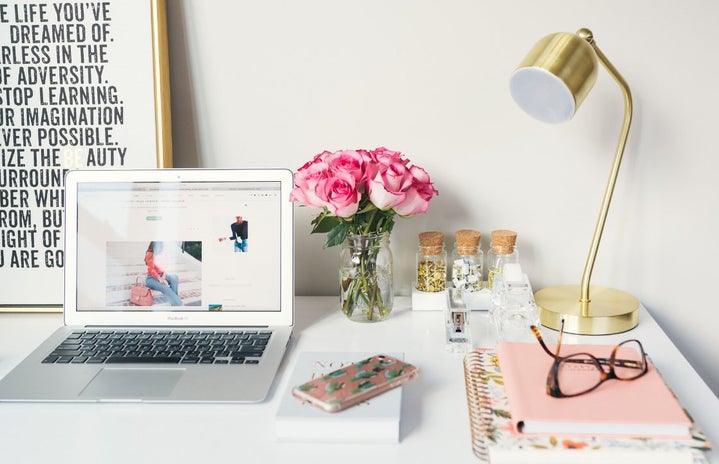For many, their New Year’s resolution was to become more organized, whether that be their life or their work. With its simplicity and versatility, bullet journaling is such a great way to organize your entire life. But, with so many options, where exactly should you start? Below are the fundamentals of bullet journaling.
Supplies
Journals – You can use any notebook to bullet journal, but there are journals made specifically for the activity. Each journal below has qualities that make them stand out. It is up to you which qualities are the most important for your journal.
–Leuchtturm1917: The Leuchtturm brand makes journals specifically for bullet journaling. What’s good about these journals is that they have pre-numbered pages, a pre-made index, a pocket on the back cover, and bookmark ribbons. The only con about these journals is that they are very pricey, costing about $20.
–Dreamworks Ink: Standard Issue Notebook No 07: This is a normal journal that has dot grid pages. While it doesn’t have everything that a Leuchtturm journal has, it is still a good option and is less pricey – only $13. The Dreamworks Ink journals have a premade index and two bookmark ribbons. Also, on the website there are many different journal options other than No 07, giving a little more choice in which journal you use. Notebook No 07 is personally the journal I use and it works really well.
Pens – There isn’t a specific type of writing utensil you need to use for a bullet journal. I suggest a black pen, since it is fairly simple and often a go-to for many. Below are two really good options for black pens.
–Muji 0.38: A Muji 0.38 black pen is what I use for any type of writing. It has thin lines and writes really smoothly. There are also different point size options if you want different size lines. It is really good for bullet journaling since the writing is so smooth and clean.
–Frixion ball clicker: This is the perfect pen for people who are prone to mistakes. Frixion ball pens are erasable. They are really good for bullet journaling since you can clean up any mistake you make. Unlike other types of erasable pens, the ink is dark and erases completely.
Artistic Supplies – These next few things are for the people that want to get a little fancier and more artistic with their journals. These are not necessary and are completely optional.
–Muji 0.5 colored pens: Like the Muji black ink pen, these colored pens are really great. The pack of 12 pens has a great assortment of colors and the pens write well. They are perfect for when you want to add a little more color to your journals but don’t want to get too artsy with markers.
–Zebra Mildeliners: Zebra Mildliners are dual-tip markers. They have a wide tip on one end and a fine tip on the other, making them very versatile. The colors don’t bleed through paper and they have a great color selection. These markers are good for when you want to highlight things or even try drawing designs in your journal. They are a great first step into adding color and designs into your journal without too much effort or artistic skill.
–Crayola Supertips: Like the Zebra Mildliners, the Crayola supertips don’t bleed through the page and have a fine tip good for drawing. The set comes with 50 markers and a wide color selection. They are perfect if you want to get more into drawing and making your journal more colorful.
Sections
These are the basic sections of a bullet journal. None are mandatory to include in your bullet journal, though they are the most common. This is what is great about bullet journaling: you customize it to exactly what you need.
Index – Your index is the way you keep track of where everything is in your journal. You simply write the title and page number of everything, so that when you need to look at it, the page you’re seeking is easy to find.
Key – Your key is where you keep track of all your bullets and color codes. You can be as simple or intricate as you please with how you create your bullets. The purpose is to find a system that works for you.
Yearly Spread / Future Log – The yearly spread and future log are where you keep track of important dates in the upcoming year. A yearly spread is when you have an entire year in view. A future log, on the other hand, is often more detailed and only covers six months at a time.
Monthly Spread – A monthly spread is where you keep track of everything going on during the month. Many people choose to have a dedicated theme for every month and will decorate accordingly. However, the only necessary parts of a monthly spread are your habit trackers (more below) of the month and important dates of the month.
Weekly Spread / Daily Spread – Similar to the monthly spread, weekly and daily spreads are where you keep track of the important things during the week or on a specific day. Depending on how much you have for a given day, you may only need a weekly spread. Daily spreads are good for when you need to plan out your entire day in detail. Weekly spreads are for when you only need to keep track of a few things each day.
Collections
Collections are various one, or two, page spreads to record your progress with various things throughout the year.
Habit Trackers – Habit trackers are a way to record progress with different habits such as drinking water, sleeping, or money spent. They are a great way to keep up with various habits or to work on other New Year’s resolutions.
Other – Collections are a great way to keep track of basically anything. Some of the more common types of collections are movies watched, books read, things to remember, dream trackers, etc. This is the most customizable aspect of a bullet journal. You are free to keep track of as many or as few things are you want.
Now that you understand all the different parts of bullet journaling, grab your supplies and get organized!
Want to keep up with HCBU? Make sure to like us on Facebook, follow us on Instagram, check out our Pinterest board, and read our latest Tweets!



